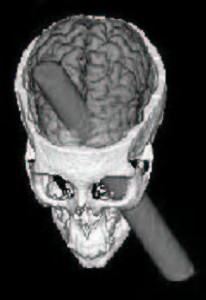
Picture in the public domain: Young Woman Thinking by Petr Kratochvil
♦For a detailed and clearly written introduction to the brain and nervous system, which includes a description of some of the misconceptions about the brain, read this page from the US National Library of Medicine:
◊http://www.ncbi.nlm.nih.gov/books/NBK20367/
♦This Deakin University page provides links that allow

you to read the story of Phineas Gage, whose brain was irreparably damaged by a work accident and whose changed personality and abilities provided evidence for early researchers on the importance of the frontal lobe:
◊http://www.deakin.edu.au/hmnbs/psychology
/gagepage/
♦In the 1960s, one way of dealing with a certain kind of serious epilepsy involved cutting through the corpus callosum, which connects the two hemispheres of the brain and allows the left and right hemispheres to communicate. Patients who underwent this operation provided experimenters with fascinating information about the role of each hemisphere, in a series of split-brain experiments that are summarised simply and visually at the Nobel Prize site below:
◊http://nobelprize.org/educational/medicine/split-brain/
These experiments were undertaken by Roger Sperry, who won the Nobel Prize in 1981. This link allows you to follow the path of his experiment and draw conclusions for yourself about the role of each hemisphere of the brain.
At the Neuroscience for Kids website you can also read an account of the brain’s hemispheres and of the split-brain experiments.
http://faculty.washington.edu/chudler/split.html
♦Go to this site in order to watch a 3D brain demonstration:
◊http://www.pbs.org/wnet/brain/3d/index.html
♦You can also read about and experience how the motor cortex was mapped by visiting these pages:
◊http://www.pbs.org/wgbh/aso/tryit/brain/
cortexhistory.html
◊http://www.pbs.org/wgbh/aso/tryit/brain/
cortexhistory2.html
♦The Genes to Cognition site provides expert discussion of the role and value of each type of neuroimaging technique used to study the brain:
◊Professor Wayne Drevets describes and evaluates neuroimaging techniques
◊Dr Johan Jansma describes and explains fMRI imaging techniques and shows a patient undergoing a scan in this video
◊ By visiting this site and clicking on the brain picture, top right, you can view a 3D model of the brain from any angle. Click on the top left to view any of the 29 individual structures of the brain, which you can also view. Read the account of each by scrolling down the left-hand side of the screen.
(You can also download the “3D Brain” to an i-Phone or i-Touch by going to i-Tunes and searching for the App with this name. It is created by the experts at Genes to Cognition Online.)
